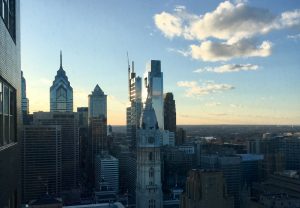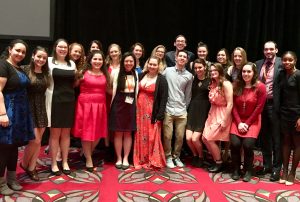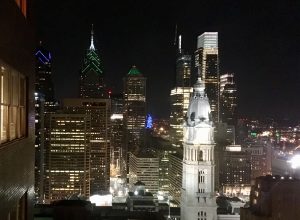Symposiums and conferences are times when professionals gather to share information, techniques, and participate in activities that will improve their skills. The Student Chapter of the American Veterinary Medical Association, or SAVMA, held its veterinary student symposium this past week. It was a great opportunity for students of all veterinary disciplines to mingle with one another and with successful veterinarians in their field. This year’s SAVMA Symposium was held at the University of Pennsylvania’s veterinary college, PennVet, in the city of brotherly love.
At the symposium, students had the opportunity to attend lectures in a variety of veterinary medicine fields, from small animal specialty medicine topics to large global scale issues in One Health. As a student interested in zoo and wildlife medicine and One Health, I attended many interesting lectures on topics from “Marine Mammal and Sea Turtle Strandings” to honey bee biology and pathology.
A personal favorite of mine was one lecture that discussed the role of a zoo veterinarian in conservation. The speaker discussed the varying degrees with which international medicine can be incorporated in a zoo veterinarian’s career, and that each individual chooses how large of a role it plays in their life. While one person may want to spend their entire career working on the conservation of a particular species in a particular region of the world, others can work on more short term projects for three to four weeks, and return to their “home base”. Listening to the stories of other veterinarians who chose one path or another encouraged me to imagine myself in their shoes. This lecture resonated with me because it allowed me to critically evaluate which path was best for me in light of my life goals and priorities.
In addition to the many lecture topics that were covered, there were also a variety of wet labs and day trips for students to attend during the symposium. These labs and trips also spanned many disciplines in veterinary medicine, including small and large animal medicine, One Health and Zoonoses, lab animal medicine, and much more! Behind the scenes tours of the Philadelphia Zoo and the Adventure Aquarium were top of the list for many zoo and wildlife oriented students. For students interested in zoo and wildlife medicine, available wet labs covered topics such as reptile physical exam, fish diagnostics, wildlife necropsy, and comparative medicine. I signed up for two wet labs, one on comparative anesthesia, and the other on ferret surgery.
Myself and a group of students from various veterinary schools around the country caught a bus together early in the morning to attend the comparative anesthesia lab at PennVet. The lab kicked off with some mice handling skills, since we were using mice as our model. During the lab, we discussed different methods of anesthetizing different species of animals, as well as various drugs used on different species. We split into three groups of four and each student anesthetized one mouse. The different groups anesthetized their mice using either intraperitoneal or subcutaneous injection, while the individuals in each group anesthetized the mice using a different combination of drugs. We examined the different drug combination protocols and each protocol’s effects on the mice by careful monitoring, taking note of any side effects and how long it took for the mice to start feeling sleepy and subsequently lose their righting reflex. Throughout the lab, we discussed the different planes of anesthesia and how to evaluate whether or not an animal was in a surgical plane of anesthesia by testing a variety of reflexes, such as palpebral and withdrawal reflexes. We then safely recovered all the mice and regrouped to review anesthetic machines and gas anesthesia, which is another form of anesthesia that allows for rapid induction and recovery from anesthesia.
The next afternoon, I attended a ferret surgery lab, in which we discussed the diagnosis and variety of treatment methods of insulinomas and adrenalectomies in ferrets, as well as the most common surgeries that most ferrets need in their lifetime. The discussion detailed a step-by-step approach to diagnosing adrenal disease and conducting an adrenalectomy surgery on a ferret. Afterwards, we were able to practice performing adrenalectomies on cadaver specimens. While our bodies may look symmetrical, they most definitely are not internally. Removing a diseased left adrenal gland is simple in a ferret, since it is located amongst fat near the left kidney. The right kidney, however, lays on top of a critical blood vessel in the ferret, so surgery can be much more complex when removing a diseased right adrenal gland. Since my partner and I finished early, we also practiced completing a spay surgery on our ferret, and afterwards practiced different suture methods and using a skin stapler to close our abdominal incision. Next, we split into groups and practiced our communication skills with mock clients, who were lab volunteers. Each volunteer set up a scenario, and we, as veterinarians, would talk through the possible diagnoses and treatment options. Since surgery is a personal interest of mine, I enjoyed the opportunity to learn about a new and common surgery done in ferrets, while joking around with the wonderful PennVet clinican who was supervising the lab.
In addition to all these events, students also had the opportunity to attend many professional development talks on varying subjects, including talks that addressed approaches to studying for the North American Veterinary Licensing Exam (NAVLE), compassion fatigue, diversity issues, and business strategies. There were even yoga sessions, academic and athletic competitions, as well as a large trivia competition that were held during the symposium. These fun events helped students break the ice and intermingle while fostering some friendly competition.
The symposium was a great opportunity to establish new relationships while rekindling old ones. I was able to meet zoo and wildlife veterinarians who were living my dream. We conversed about the various unique paths they took to reach their goals, and how their personal priorities affected those decisions. I was also fortunate to have spent some time with old professors and classmates from my undergraduate career at Rutgers. Seeing how old friends have succeeded in their endeavors is refreshing and exciting!
SAVMA Symposium 2018 was a highly rewarding experience, both because of the great opportunities it afforded me in professional development, and for the fun times I had with old and new friends. I highly recommend that all veterinary students, no matter what field or species you are interested in, attend SAVMA Symposium at least once during their time in vet school.
ABOUT THE AUTHOR
Mary is a second year vet student from Staten Island, NY. She received her Bachelor of Science from Rutgers University in 2016, with a major in Animal Science. She is passionate about zoo and wildlife medicine, conservation, and education, and aspires to build a career around zoo/wildlife surgery and anesthesia.



